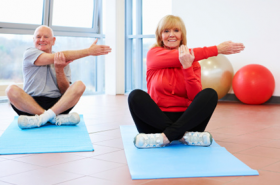Best Practices When Fitness Training Older Adults
You can be influential in fitness training older adults by helping them realize the benefits of staying active and making exercise enjoyable. You know that getting older doesn’t mean throwing in the towel on exercise and succumbing to a sedentary lifestyle. As we age, regular exercise becomes essential in keeping our bodies and minds healthy, and allows us to maintain our independence longer into our old age.
The benefits of exercise make a compelling case for engaging in regular exercise at any age, and if an older client has come to you for help achieving their fitness goals, they’re on the right track! An easy first step in helping them achieve those goals is to share with them the ways that exercise can support better overall health including:
- Combating a slowing metabolism and helping to maintain a healthy body weight
- Building strength and stamina
- Fighting osteoporosis to prevent loss of bone mass
- Helping to relieve arthritis
- Improving balance and coordination, reducing the risk of falling
- Boosting mood
- Reducing anxiety and worry
- Increasing flexibility
- Reducing the impact of illnesses
- Improving sleep
- Keeping the brain active, which helps to prevent memory loss and even dementia
- Allowing them to remain independent for longer and continue doing activities of daily life
The second step in working with your older clientele is to complete a general fitness assessment. If you work for a fitness facility, this may be part of a client’s orientation at the facility. You’ll want to understand what the individual’s current state of health is. Do they suffer from a chronic illness such as arthritis or diabetes? Have they experienced any major illnesses in the past, such as a stroke or heart attack? Are they taking routine medications? An individual’s health history will determine what kinds of exercise they should and shouldn’t engage in.
Next, you’ll want to ask about the client’s fitness goals. Do they want to increase overall strength so they can lift a grandchild? Do they want to improve endurance so they can take longer walks with a friend? Is improved balance a motivator? Or maybe their physician has advised they get more exercise. Whatever their goals, you can assure them they’ve made a great choice in beginning an exercise regimen.
Once you’ve assessed the client’s health status, you can develop a fitness plan tailored to achieve their goals. To help keep them engaged, motivated and putting forth their best effort, consider the following techniques when creating the plan:
Start at a slow pace. This will help the client get familiar with the motions of the exercises, keep them from overexerting themselves and help reduce the risk of injury.
Incorporate a variety of exercises in small increments. Be sure to include more of the exercises the client seems to enjoy the most.
Point out the short-term benefits of their exercise. These benefits include increased energy and improved mood.
Aside from working out at the gym, it’s important for older people to maintain a level of activity in their daily lives as well. You can help encourage them to do this by creating a functional fitness program that incorporates everyday activities, using objects found at home, as a means of exercise. Carrying a bag of groceries, walking up a short flight of stairs, vacuuming—these are all motions that can be incorporated into an exercise routine.
An important part of working as a fitness trainer is the ability to recognize the signs of someone struggling beyond normal exercise fatigue. This is especially crucial when training older adults due to the higher risk of injury and other complications. If the person you are training complains of pain, or appears light-headed or short of breath, have them stop exercising immediately. If the condition does not subside right away, call the client’s doctor, or emergency services, as necessary.
As a fitness trainer, your job is to help your clients achieve their fitness goals with a personalized training plan appropriate for their age. It’s equally important to encourage fitness as a lifestyle that they’ll stick with and find enjoyable at any age.
Check out more tips for managing your Fitness Training career.
Customer Feedback
-
Thank you so much for your prompt response. Might I add, Veronica was a delight to work with and her professionalism and attention to detail made this an overall pleasurable experience.

Earl W.




















